Firefighting Drones: Technology and Battery Power
The Role of Drones in Firefighting
Drone technology has revolutionized the firefighting field. Companies like DJI have popularized lightweight drones, allowing firefighters to use drones to survey high-rise fires closely, providing commanders with accurate and direct insights. However, traditional small drones are only suitable for reconnaissance, and actual firefighting still relies on conventional methods such as internal attacks by firefighters and high-rise water spraying trucks.
Limitations of High-rise Water Spraying Trucks
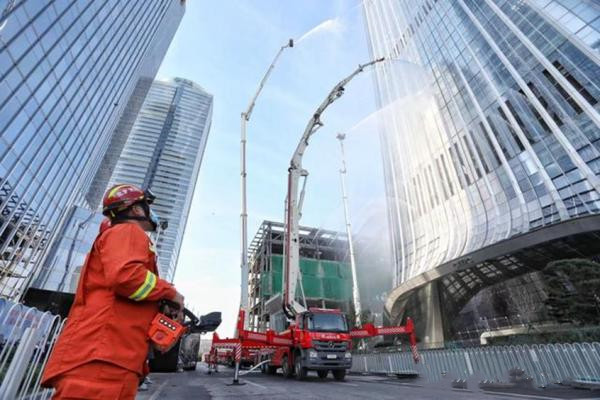
High-rise water spraying trucks can perform firefighting operations at certain heights, but their effectiveness is limited by site conditions. These trucks require sufficient ground load capacity and space to extend their support legs, which may not be available in densely populated urban areas. Additionally, the current maximum height these trucks can reach is limited, making them ineffective for extremely tall buildings.
Innovative Advantages of Firefighting Drones
Firefighting drones offer several innovative advantages:
Adaptability to Various Sites: Drones require minimal space for takeoff and can operate in narrow streets, tree-filled areas, and spaces with overhead wires.
Maneuverability: Drones can fly directly to the fire scene for firefighting, bypassing ground conditions that limit traditional equipment.
Precision Targeting: Drones can extinguish fires precisely at the source, avoiding the collateral damage caused by the "flooding" method of traditional high-rise water spraying trucks.
Collaborative Operations: Multiple drones can work together to suppress fire spread from different angles.
Controlled Impact: Drone firefighting has a minimal impact on surrounding areas, providing more efficient and precise firefighting.
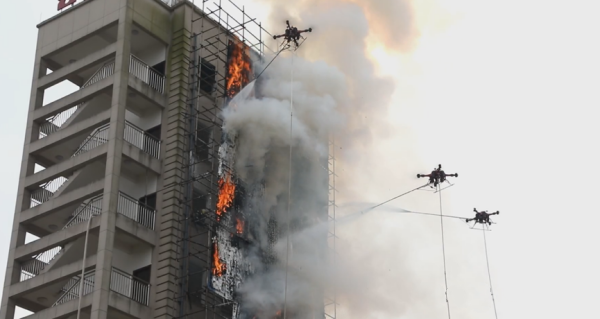
Specific Requirements for Firefighting Drones
Compared to general-purpose drones, firefighting drones require special design and higher performance standards:
Task Load: Firefighting drones must carry hoses and stabilize while spraying water, requiring a load capacity at least 1.5 times that of general drones.
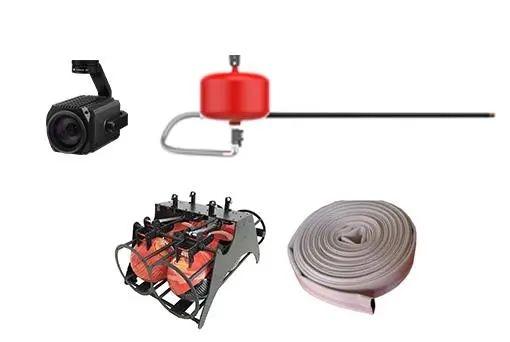
Operational Environment: Firefighting drones must operate stably in harsh weather and turbulent conditions.
Flight Control Algorithms: These drones need high-frequency attitude adjustments to ensure precise firefighting.
Airframe Structure: The structure must support high-frequency dynamic adjustments, ensuring system rigidity.
Aerodynamic Design: Firefighting drones must balance load capacity with minimized dimensions to allow quick deployment and reduce collision risks during flight.
Application of Electric Drones in Firefighting
Electric drones are preferred for firefighting due to their environmental friendliness, quiet operation, and ease of use. Key characteristics of their battery power systems include:
High Energy Density: Lithium-ion and future solid-state batteries provide long flight times.
Lightweight: Batteries must be lightweight to minimize impact on flight performance.
Fast Charging: Quick charging technology reduces ground time, increasing mission efficiency.
High Discharge Rate: Batteries must provide high power output to meet flight and operational demands.
Long Cycle Life: Batteries need a long charging and discharging cycle life to lower operating costs.
Safety: Batteries must have safety features to prevent overheating, fire, and other risks.
Battery Management System (BMS): Advanced BMS monitors battery status in real-time, optimizing performance and improving safety.
Modular Design: Batteries should be easy to replace and maintain, enhancing drone availability.
Environmental Adaptability: Batteries must operate stably in various temperatures and humidity conditions.
Application Cases of Battery-Powered Drones
Firefighting Drones: Equipped with high energy density batteries, these drones can hover over fire scenes for long periods, conducting reconnaissance and firefighting.
Cargo Delivery Drones: Utilizing high discharge rates and long-endurance battery systems, these drones can transport goods over long distances efficiently.
Agricultural Drones: Used for pesticide spraying and field monitoring, these drones rely on battery management systems to ensure long, stable operations.
Enhancing Battery Power Systems for Firefighting Drones
Battery power systems are crucial for the effectiveness of firefighting drones. Here are several areas where advancements are making a significant impact:
Energy Density and Weight: Advancements in battery technology focus on increasing energy density while keeping weight low. This balance is vital for drones to achieve longer flight times without compromising their maneuverability and load capacity.
Charging Infrastructure: Developing rapid charging infrastructure at fire stations and mobile units ensures that drones can be quickly redeployed during extended firefighting operations. Innovations in wireless and fast charging technology are also being explored to minimize downtime.
Thermal Management: Effective thermal management systems are essential to prevent overheating and ensure battery longevity. New materials and cooling techniques are being integrated into battery designs to handle the high power demands of firefighting drones.
Smart Battery Management: Advanced BMS not only monitors battery health and performance but also predicts potential failures and optimizes charging cycles. This technology ensures that drones are always ready for deployment with minimal risk of power loss during critical operations.
Sustainability: Research into more sustainable battery materials and recycling processes aims to reduce the environmental impact of large-scale drone deployments. This is particularly important as the demand for firefighting drones increases globally.
Comprehensive Summary
Drone technology, particularly electric drones, shows immense potential in firefighting. By continuously optimizing battery power systems, increasing load capacity, and enhancing intelligence, drones can execute firefighting tasks more efficiently and precisely, compensating for the limitations of traditional firefighting methods. In the future, with the maturation of new battery technologies and the improvement of drone systems, electric drones will play a more crucial role in firefighting and other emergency rescue fields, providing strong support for protecting lives and property. If you have any questions or needs about our button cell batteries, please feel free to contact us at info@grepow.com.
Related Articles
-

Powering the XR Revolution: Grepow’s Custom Battery Solutions at AWE USA 2025
2025-06-06 -

Grepow to Showcase Custom Medical Battery Innovations at Medical Taiwan 2025
2025-05-21 -

Drone Training Power Guide: LiPo Batteries & Chargers
2025-05-14
Related products
-
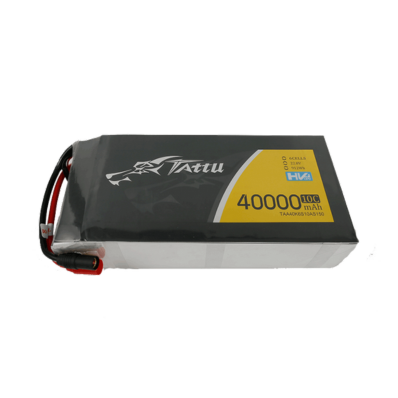
Tattu 6S 40Ah 22.8V 10C HV Lipo Drone Battery
-
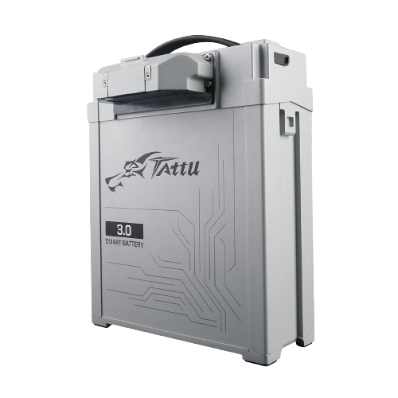
Tattu 3.0 14S 28000mAh 53.2V 25C HV Lipo Smart Drone Battery
-
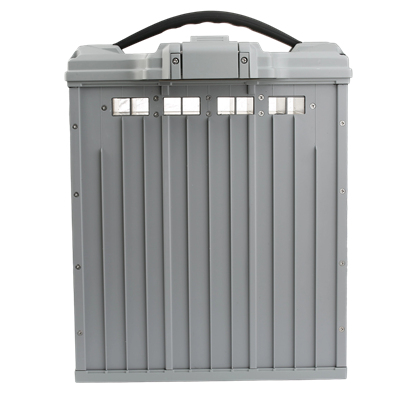
Tattu 4.0 18S Lipo 30Ah 68.4V Smart UAV Drone Battery
















































